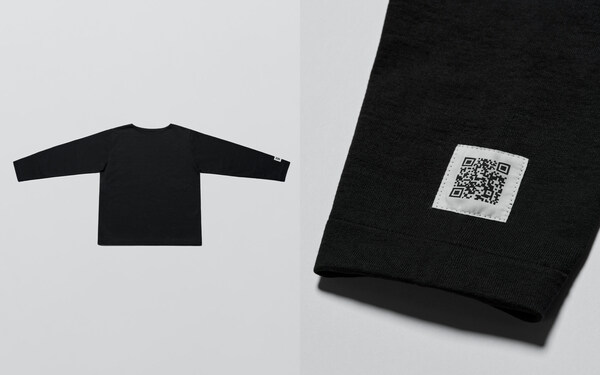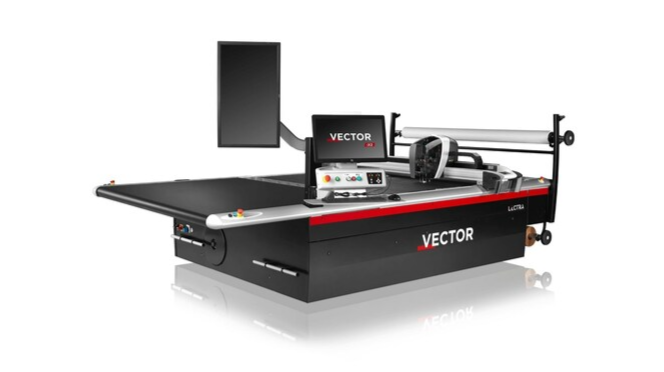Spiber's groundbreaking initiative, the biosphere circulation program, presents a pioneering methodology for upcycling biobased and biodegradable textile and agricultural waste through the utilization of its proprietary fermentation technology. The primary objective of this program is to propel society towards the creation of fully circular textile products that can be regenerated into an innovative protein material known as "Brewed Protein™" at the end of their lifecycle.

Left: First demonstration product developed by Spiber and Goldwin to help identify potential challenges to solve in determining a guideline for fully circular apparel products. Right: QR code leading to a demonstration webpage showing information on materials and chemicals used to make the demonstration product. Photo courtesy of Spiber Inc. Photo courtesy of Spiber Inc.
The textile industry faces a challenge with textile recycling, with less than 1% of discarded textiles being recycled for new textile applications (Ellen MacArthur Foundation, 2017)1. Recognizing the challenges involved in end-use textile recycling, Spiber is dedicating significant resources to developing a comprehensive circulation infrastructure aiming for commercialization in the long term. The company has been testing various types of fibers, dyes, and processing chemicals that are used to make apparel products in order to verify what can be efficiently digested into nutrients. This information is being used to inform the development of requirements for textile products which will be published in the near future to ensure that the industry has the tools needed to adopt this innovative process.
Understanding the pressing need to confront the challenges we currently encounter, Spiber advocates for a collaborative approach to expedite research and development, hastening the implementation of this cutting-edge system. In support of this vision, Spiber's long-term partners Pangaia and Goldwin have joined the program. This collaboration aims to catalyze the transition from a linear "take-make-use-dispose" model to a circular "take-make-use-reuse" model.
"PANGAIA is delighted to explore the next phase of its partnership with Spiber by joining its biosphere circulation project. At PANGAIA, we are focused on accelerating the development and broader adoption of problem-solving technologies and materials into the fashion industry. This project aligns perfectly with those goals and our research focuses by tackling one of the industry's biggest and most complex issues – waste." – Craig Smith, Research & Development Director at PANGAIA
The brands will support Spiber to accumulate valuable data and develop a comprehensive product design guideline that enables the decomposition of garments into biological nutrients, which can then be used as resources for production of upcycled materials. Furthermore, the brands will contribute to the advancement of product design guidelines applicable to a wide range of garment types, promoting industry-wide adoption of this sustainable approach.
As a first step, Spiber has worked with Goldwin to create a demonstration product to identify potential challenges that need to be solved in order to further develop the guideline to design a fully circular final product that the fashion industry can comply with.
Knowledge of what has been used to make products—from raw material to consumer goods—is critical for circularity at end-of-use. Accordingly, Spiber has created a demonstration webpage where users can access detailed breakdown information of materials and chemicals used to make the product. This webpage is just a glimpse into the company's vision for building a platform to enable their circularity solution through transparent access to data to enable verification of whether a product is or is not "digestible to nutrients" at end-of-use. During the process of development, Spiber has already identified several potential challenges that the industry needs to overcome. (Demonstration webpage, available until July 26: https://www.b-source.co/basque-shirt-demo)
The demonstration product will be prominently displayed at Innovation Hub at Future Fabrics Expo in London, UK, from June 26 to 28. During the event, Kenji Higashi, Executive Vice President of Business Development, Sales & Sustainability, will participate in a panel discussion on June 27 to shed light on the challenges encountered and provide further insights on the dissemination of biomaterials and the circular economy.
Given the pressing urgency of our current situation, it is vital and inevitable to confront resource depletion issues and establish a comprehensive circulation model and infrastructure across the industry. Spiber ardently advocates for a collaborative approach, welcoming industry players to join forces and enhance research and development efforts in pursuit of a more sustainable future.
|
1. Ellen MacArthur Foundation, A new textiles economy: Redesigning fashion's future (2017) |
Progress to date
- Challenges specific to this demo product
To make this demo product compatible with biosphere circulation, the garment was assembled with cotton thread in place of polyester thread. This change may slightly impact the performance of the product, as cotton thread doesn't have the same stretch, strength, and performance properties as polyester thread. This may cause the shirt to be slightly more prone to wear and tear around the neckline and sleeves at the seams.
- Challenges involved in the development of any textile product
There are challenges to circulating chemically processed and colored textiles. The chemicals and colorants must be identifiable when textiles reach end-of-use, and they must be confirmed to not hinder the "degradation to nutrient" process. We are currently focusing research efforts to identify the types of chemicals and colorants that are acceptable with the process, and are actively gathering data through lab-scale testing.
Brewed Protein™ fibers
Brewed Protein fibers are lab-grown, plant-derived, circular materials made through a proprietary microbial fermentation process. The fibers are a compelling solution to the growing demands of animal and petrochemical-free fibers to address numerous pressing environmental issues and risks. The potential environmental impact of a forward-looking Brewed Protein fiber production plan was found to be significantly smaller than cashmere and merino wool, largely due to the lower environmental impacts of inputs for Brewed Protein polymer production (primarily plant crops and renewable electricity) when compared to livestock farming for cashmere and wool production. Production scale has been growing and Brewed Protein fibers, yarns, and fabrics are now available for purchase at commercial scale.
Spiber's Sustainability webpage: https://spiber.inc/en/sustainability/
Spiber Inc.
Established in September 2007, Spiber Inc. is a Japanese biotechnology startup utilizing cutting-edge synthetic biology, polymer science, and material science for the development of its novel Brewed Protein materials made from plant-based sugars utilizing microbial fermentation technology.
Spiber website: https://spiber.inc/en/
Spiber is a trademark or a registered trademark of Spiber Inc. in Japan and other countries.
Brewed Protein™ is a trademark or a registered trademark of Spiber Inc. in Japan and other countries.
PANGAIA
PANGAIA is a purpose-driven leisure lifestyle company bringing problem-solving materials science innovations to the world.
We are a global collective of one heart and many hands - scientists, technologists, designers – creating essential products from innovative tech and bio-engineered materials powered by nature. Our vision is to inspire and accelerate an earth positive future as we design a business model where our products are better for the planet than if they did not exist. Every product we create is born from science and purpose, each solving an environmental problem of the industry.
Pangaia website: www.pangaia.com
GOLDWIN INC.
Founded in 1951, GOLDWIN Inc.'s original brand Goldwin proposes products that combine minimalist design with rationality, comfort, and convenience, derived from its experience with skiing and the outdoors, as well as Japanese aesthetics.
Since 2018, Goldwin has opened directly managed stores in Tokyo (Marunouchi and Harajuku), the United States (San Francisco), Germany (Munich), and China (Beijing), and is actively building a global base.
Goldwin website: https://www.goldwin.co.jp/goldwin/
 Pages you might like
Pages you might like




 Today's topic
Today's topic







 Latest information
Latest information
 Follow official account
Follow official account
 Online support
Online support
 鄂ICP备2022017323号
鄂ICP备2022017323号
 鄂公网安备 42018502006493
鄂公网安备 42018502006493
 Launch Exhibition
Launch Exhibition
 Release information
Release information








